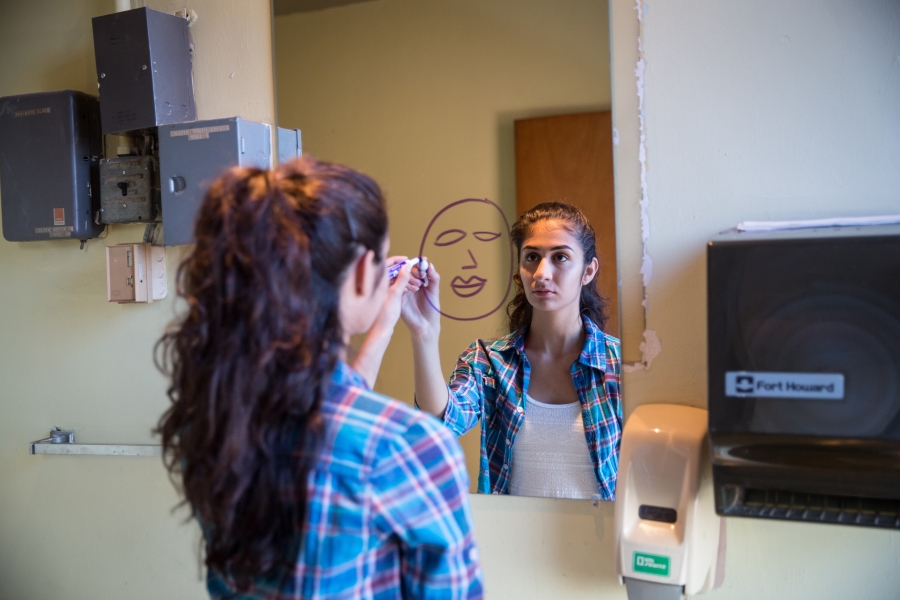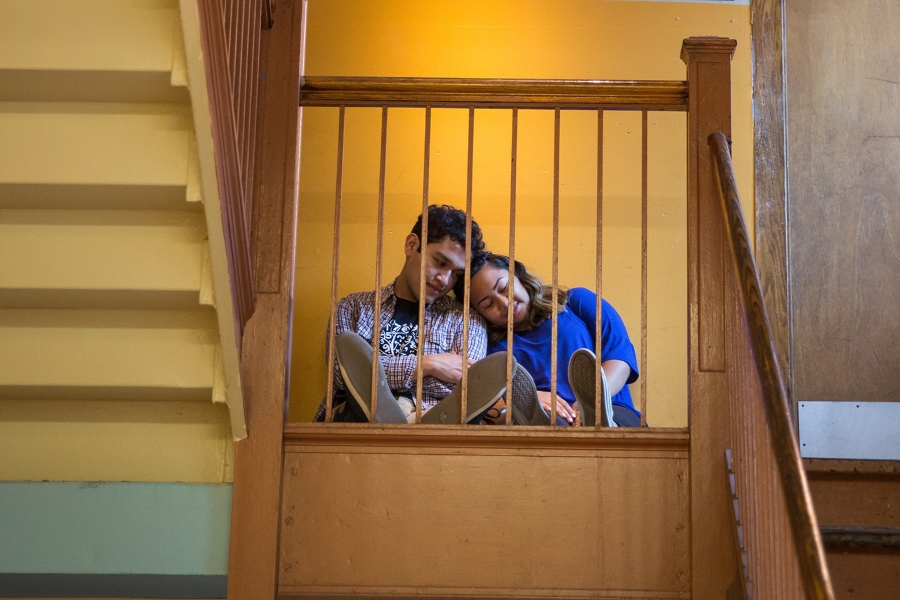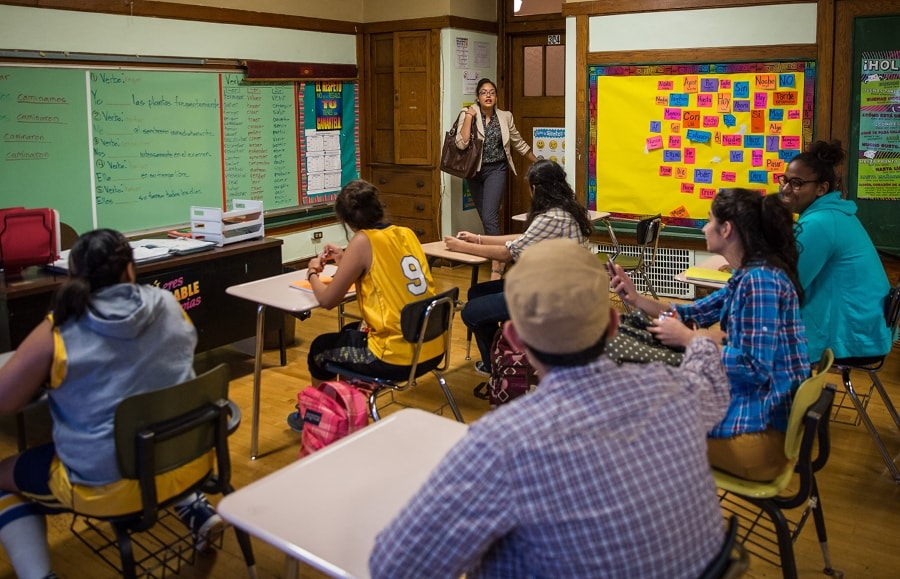Albany Park Theater Project (APTP) knows how to move around—thematically and physically. For nearly 20 years, the multiethnic Chicago youth company has created ensemble-based works on a wide range of socially relevant issues, including immigration (Home/Land), religious fanaticism and abusive families (God’s Work), and the joy of cultural diversity as expressed through food (Feast). APTP’s pieces have traveled from their neighborhood home base in a Chicago Park District fieldhouse in the Albany Park neighborhood to downtown Chicago’s Goodman Theatre and the Museum of Contemporary Art.
But this past summer, APTP, in collaboration with New York’s Third Rail Projects, unveiled its most ambitious journey yet. In Learning Curve (currently running through Dec. 17), an abandoned parochial school in Chicago’s Logan Square neighborhood becomes the setting for a site-specific show that takes audiences all over the building and into the heart of what it means to negotiate the contested territory of public education in America. The young company is made up of students at public high schools in Chicago. The school, renamed “Ellen Gates Starr High School” in honor of an educational-reform pioneer who co-founded Hull House with Jane Addams, becomes a character of sorts in the show.
Producing artistic director David Feiner, who co-founded APTP in 1997 with his late wife Laura Wiley, notes that the roots of the show aren’t that different from past productions. “It fits in with what we’ve always done,” he says. “There’s a grounding in real-life stories and ethnography. Like almost every show in our history, it’s inspired by interviews conducted by the youth ensemble members. Students, teachers, parents, and administrators shared their experiences with the Chicago public schools.”
He adds, “Practice-wise, we then work collaboratively to devise from what begins as dozens of first-person stories and find ways to theatricalize them—identifying the themes that we as a group find compelling and important, the characters we want to focus on. Rather than a documentary theatre style, where you stick verbatim to the interview text, we talk about it being inspired by those texts and encourage thinking about the in-between in some of the moments.”
The show takes different segments of the audience into different directions. Rather than a “choose your own adventure” ambulatory experience where audiences wander through various rooms and vignettes on their own, a la Punchdrunk’s Sleep No More, cast members direct audiences (limited to 40 people per performance) up and down stairs, into classrooms, locker rooms, closets, and bathrooms.
Some of the scenes are one-on-one. On the day I attended, I received individual career advice from a comically distracted guidance counselor (“ice-road trucker” was his suggestion), and also experienced a quiet moment of connection in a tiny bathroom, where a young woman handed me a marker and invited me to answer the question inscribed on the mirror— “What do you hate about your body?”—and then erased my answer in an act of empathetic solidarity.
As structured, it’s impossible to see all the scenes in one outing. Feiner estimates that each audience member sees about 60 percent of all the material.
It is a mammoth undertaking, to put it mildly, and it’s one that required the skills and insights of Third Rail to fully pull it off.

Feiner saw Third Rail’s Then She Fell, incorporating the writings of Lewis Carroll and staged in an old hospital ward in Brooklyn, a few years ago and felt that the two companies could combine their respective strengths. “We have been looking for ways to create a deeper engagement between audience and performers,” he says. “We’ve always tried to create an intimate space for storytelling by using theatrical styles that acknowledge the presence of the audience and acknowledge that the performers are simultaneously themselves and the characters they play.”
Jennine Willett, founder and co-artistic director for Third Rail, notes that Feiner originally approached her about doing an educational residency in Chicago with the APTP ensemble, “just to give them a taste of the kind of work we do. We also talk a lot in our work about status over the audience–how do we create the invisible rules of the world of the piece–and we wondered what that would be like if teens were playing to adults.”
From that initial residency in April of 2014, Learning Curve grew into its current incarnation. Two different workshop productions helped the team of artists—which includes 32 youth performers, 8 directors, and a large team of designers and production assistants—hone the vision of the piece. (The show’s final budget, which Feiner estimates at “about a half-million dollars,” is also by far the highest in APTP history.)
From the start of the show, when we walk through metal detectors and are herded in front of a camera for an ID picture, we’re also very aware that we’re in a specific kind of public school. An announcement over the loudspeaker during “homeroom” reminds us that “half of you won’t be here at graduation” and urges us to “make good choices.” A scene in which we’re asked to take the PARCC math test (a real test whose acronym stands for “Partnership for Assessment of Readiness for College and Careers”) qualifies as a nightmare for certain innumerate arts journalists.
A later scene puts us in the basement, where a teacher is “juking the stats” (to borrow a phrase from the HBO series “The Wire”)—i.e., changing answers on tests so the school won’t be shut down for not meeting academic standards. “These tests —they don’t tell us anything about who you are,” she explains with a mix of defiance and anguish.

But Learning Curve, while very much about urban public education, also has moments that resonate with anyone who attended high school. My journey also included helping a winsome teen boy ask his girlfriend to prom, which took us into a broom closet transformed by twinkling lights into a romantic oasis.
Making all those settings required lots of intricate planning on the part of the design team. Scenic designer Scott C. Neale and objects and installation designer Ellie Terrell worked together closely to create the 26 different environments of the show. Some of the installations are eye-popping: A locker room features artful installations inside the lockers paying homage to everything from vinyl records to family ancestors.
“The lockers really came to life through the APTP students,” says Terrell, who also works as a teaching artist in a Chicago public high school. “In the last round of workshops, the APTP kids developed characters and then worked out how to build those characters through the installations – how would they portray themselves through a magical surreal installation? It takes on a heightened surrealism, which actually mirrors that feeling that you have in high school of things inside you that don’t mesh with the reality of the school space.”
In one scene I experienced, audience members were invited into an art room to weave pieces of cloth into a giant web—an example of creating a safe space away from the stresses of the school day.
For Neale, who has worked on theme-park design, the challenge wasn’t just the scale but the coordination. “We don’t have a script to work from until close to opening,” he notes of the APTP process. “On the design end, we have to figure out how to interpret what is happening in the devising process, and what the rooms are going to look like. We bounced ideas off the directors and they bounced ideas off us.”
With Terrell, he notes, “I would provide bigger-picture sketches and she would brainstorm off those. With such a large project, the challenge is also to balance the narrative throughlines and make it unified, but also make it work for each audience member.” Durability was also a factor, says Neale. “We had to take into account that people will be touching things and actors are climbing on things.” (Some of the scenes feature students pounding and standing upon desks and chairs, in echoes of the Bill T. Jones choreography for Spring Awakening.)
Terrell notes that she also enjoyed creating the classroom environments through small details that might go unnoticed by audience members. “It was about what to write on the board. Is this an organized teacher or a messy teacher? Deciding where to put piles of paper, throwing pencils into the ceiling—those details were so much fun to really get into.”
Sound designer and composer Mikhail Fiksel notes that creating an “invisible and unobtrusive” sound environment over a four-story building with 50 different speaker zones presented many logistical challenges. “But the other challenges were more conceptual and abstract. The world of Learning Curve oscillates between various storytelling styles and experiential modes: between realism and impressionism, subtle and overt, interactive and presentational. And we found that the sound design and music can play a big role in helping with those shifts, cuing and guiding the audience, setting up the expectations and even playing with and subverting those expectations.”

For example, during the standardized-test scene, Fiksel worked closely with APTP choreographer Stephanie Paul to create a percussive soundscape—tapping feet, pencils drumming on the table—that increased the sense of frustration and anxiety. Says Fiksel, “I think we succeeded in creating a very sonically layered and undeniably immersive sequence, one that shifts from a subtle suggestion to a potentially intense visceral experience.”
The show requires a leap of faith for its viewers. As an audience member, you’re not sure where you’re being led to next or what you’ll be asked to do. Yet due in large measure to the skill and confidence of the young performers themselves, it isn’t hard to let go and follow the thread through the hallways and stairwells.
Willett says of the young cast, “They have a tremendous amount of integrity. In this type of theatre, the director just can’t sit in the balcony and give notes. You don’t know what’s happening behind closed doors in any of the scenes. There’s a tremendous amount of trust between creator and director and performer.”
Building that sense of empathy and trust is important for many reasons, and is also crucial to bridging gaps between the young cast and the audience. Feiner notes that the audience for Learning Curve “is largely adults, and a lot of them are adults who don’t have children in the Chicago public school system because their kids are older or they opted out.”
But they have also reached out to make sure plenty of public school teachers and administrators are included in the audience—and they too find moments of epiphany.
Says Feiner, “One teacher told me, ‘I was so anxious during the entire show. It was one anxiety-riddled experience after another, and I thought, are my students that anxious all the time?’ I have known her for years, she is beloved, she is empathetic and good and listens—and she still had something to discover about her students’ experience.”
The critical response has been overwhelmingly positive. In his Chicago Tribune review, Chris Jones wrote, “Most high school drama you’ll have seen will have inhabited merely a literal plane; Learning Curve embraces the symbolic, the inner life of the kid, the deeper context.”
Feiner hopes that Learning Curve will have a future life after this current incarnation. “The institution (of public education) is in triage,” he notes. “That’s something we all need to be aware of. The issues are national.”
Kerry Reid is a freelance arts journalist and critic in Chicago.


